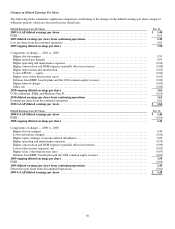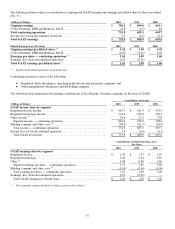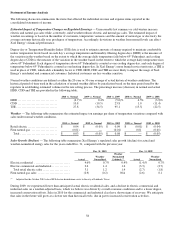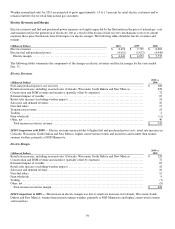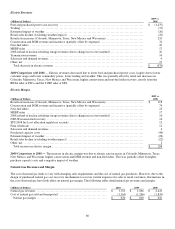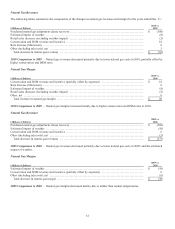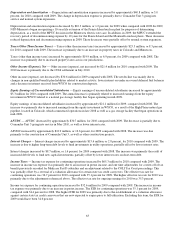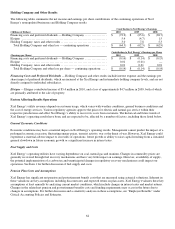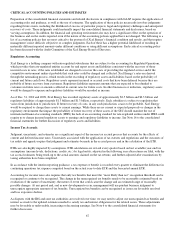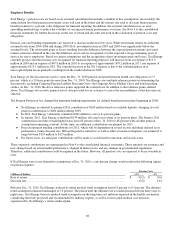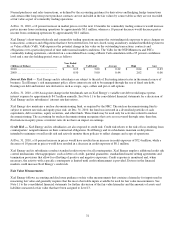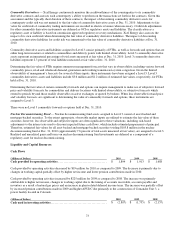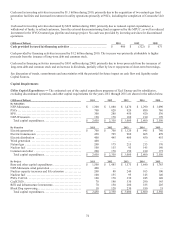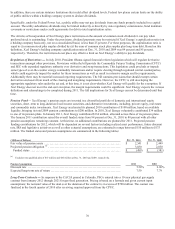Xcel Energy 2010 Annual Report Download - page 76
Download and view the complete annual report
Please find page 76 of the 2010 Xcel Energy annual report below. You can navigate through the pages in the report by either clicking on the pages listed below, or by using the keyword search tool below to find specific information within the annual report.
66
Xcel Energy expects to incur approximately $141 million in capital expenditures for compliance with environmental regulations
and environmental improvements in 2011, and ranging from approximately $144 million to $301 million of related expenditures
throughout the years from 2012 through 2015. Included in these amounts are expenditures to reduce emissions of generating
plants in Minnesota and Colorado.
See Note 14 to the consolidated financial statements for further discussion of Xcel Energy’s environmental contingencies.
Air Emissions
Xcel Energy’s operations are subject to the CAA and similar state laws and regulations. These laws and regulations regulate air
emissions from various sources, including electrical generating units, and impose certain monitoring and reporting requirements.
Such laws and regulations may require that Xcel Energy obtain pre-approval for the construction or modification of certain
projects that increase air emissions, obtain and strictly comply with air permits that contain emission and operational limitations
or mandate the installation and operation of expensive pollution control equipment at facilities. Xcel Energy will likely be
required to incur capital expenditures in the future to comply with these requirements.
Generating facilities throughout the Xcel Energy territory currently are subject to mercury reduction requirements only at the state
level. In Minnesota, mercury emissions from two generating facilities, A.S. King and Sherco, are regulated by the Minnesota
Mercury Legislation, which was promulgated in 2006 to provide a process for plans, implementation and cost recovery for utility
efforts to curb mercury emissions at certain power plants. In Colorado, eight units are subject to a mercury emissions rule passed
by the AQCC. Of those eight units, Xcel Energy only expects to install mercury emission controls on Pawnee Unit 1 by the end of
2011. The Pawnee mercury emission controls are included in the CACJA plan.
During 2008 through 2010, NSP-Minnesota completed sorbent control systems to reduce emissions at the Sherco Unit 3 and A.S.
King generating plants. Following MPUC approval, such project costs were collected through the MCR rider.
In December 2009, NSP-Minnesota filed the plans for mercury control at Sherco Units 1 and 2 with the MPUC and the MPCA. In
October 2010, the MPUC approved the plan, which will require installation of mercury controls on Sherco Units 1 and 2 by the
end of 2014.
PSCo
In April 2010, the Colorado Legislature passed the CACJA. This legislation required PSCo to submit a plan to the CPUC to
reduce NOx emissions by 70 to 80 percent from at least 900 MW of existing coal-fired generation by 2017. The purpose of the
legislation was to develop a coordinated plan of emission reductions for utility boilers to comply with current and reasonably
foreseeable CAA requirements such as regional haze, ozone nonattainment in the Denver, Colo. metropolitan area, control of
hazardous air pollutants such as mercury and acid gases along with the reduction of GHG from power plant operations. In
December 2010, the CPUC approved an emission reduction plan that included the retirement of several units, the conversion from
coal to natural gas for two units and the addition of emission controls for NOx and SO2 on three other units. The plan also
includes the installation of two new natural gas combined-cycle units to replace the retired coal-fired boilers. Costs associated
with implementing the plan are expected to be approximately $1.0 billion and are expected to be recovered through future rates
with the plan fully implemented by the end of 2017. See further discussion in Public Utility Regulation.
The EPA has required states to develop SIPs to comply with regional haze BART requirements, which included identification of
facilities that will have to reduce SO2, NOx and particulate matter emissions under BART and then set BART emissions limits for
those facilities. The AQCC promulgated BART regulations requiring certain major stationary sources to evaluate and install,
operate and maintain emission controls meeting BART to make reasonable progress toward meeting the national visibility goal.
The combination of plant retirements and the installation of emission controls resulting from the approved CACJA emission
control plan noted above will be incorporated into the regional haze SIP for Colorado as a BART alternative. As discussed above,
the state of Colorado will submit the final regional haze SIP to the EPA for its review in early 2011.
Inflation
Inflation at its current level is not expected to materially affect Xcel Energy’s prices or returns to shareholders. However,
potential future inflation resulting from the economic and monetary stimulus policies of the U.S. Government and the Federal
Reserve could lead to future price increases for materials and services required to deliver electric and natural gas services to
customers. These potential cost increases could in turn lead to increased prices to customers.


